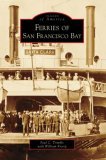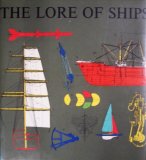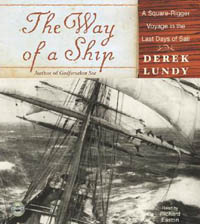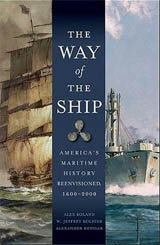 
|
Beyond the Golden Gate:
A Maritime History of California
Timothy G. Lynch
Beyond the Golden Gate: A Maritime History of California is the first book-length treatment of California's connection to the sea. Here, noted maritime historian Timothy Lynch looks at the history of the Golden State through the prism of the maritime world: we see how the region developed and how indigenous persons interacted with the marine ecosystem. We see how they and others-Spanish, English, Russian, American-interpreted and constructed the oceans, lakes and river networks of the region. The waterways served as highways, protective barriers, invasion routes, cultural inspiration, zones of recreation, sources of sustenance: much as they do today. We see how the Gold Rush transformed the region, wreaking havoc on the marine environment,and how the scale and scope of maritime operations waxed and waned in the decades after that event. In all, the delicate balance between protection and utilization is paramount. Written as part of a project with the National Park Service and the Organization of American Historians, Beyond the Golden Gate is an immersive look at the maritime history of California that will inspire additional scholarship in this overlooked but critically important field. Benefitting from hundreds of primary sources, dozens of captivating images and reflective of the latest trends in the field, Beyond the Golden Gate is sure to satisfy the curious reader, the serious historian, and the maritime aficionado.
|
 |
Donald G. Knight and Eugene D. Wheeler
Pathfinder Publishing of California, Ventura, CA, 1990
This detailed account of the sinking of the Yankee Blade includes surviving passengers, crew, and officers. Well researched. A small book and a wonderful, quick read of life of a ship. |
 
|
William H. Flayhart
W.W. Norton & Company The story of the development of the American Merchant Marine remains one of the most glorious chapters in the early history of the United States. Up until the Civil War the American sailing ships carried the Stars and Stripes around the world with honor to the nation and profit to their owners. The war and the concurrent change from sail to steam brought disaster to American shipping. By 1870 there were no American passenger liners on the North Atlantic, a sad blow to national pride. |
 
|
Jim Murrant
The book presents all the skills necessary to be able to sail competently, starting with a basic explanation of the structure of a sailing boat and the best way to set up a boat for sailing followed by a detailed discussion of the theory and practice of sailing. The practical side of sailing is emphasized. |
 
|
David W. Shaw.
Much of this book is based on primary source material: diaries, letters, and ship's logs.
On her maiden voyage in 1851, the clipper ship Flying Cloud, carrying valuable cargo and 11 passengers, sailed from New York to San Francisco around the tip of South America. The ship made the 16,000-mile trip in 89 days, 21 hours, a remarkable speed. However, more astonishing was the fact that the ship's navigator was the captain's wife, Eleanor Creesy, an experienced pilot who charted the course using then new theories about wind directions and ocean currents propounded by Matthew Maury, superintendent of the Navy's National Observatory. While Captain Josiah Perkins Creesy dealt with emergencies, his wife plotted the course, managed day-to-day life on board and coped with the sometimes rash decisions made by her husband. |
 
|
A Maritime Artist/Historian's Account of His 1892 Voyage
Charles G. Davis
Davis was considered one of the world's leading maritime model builders; his ship models now are rarely found outside of museums. He was also acclaimed as an artist, historian, and author. Around Cape Horn is his recollection of one of the first adventures at sea: sailing out of New York in 1892 at age 13 on a voyage around Cape Horn, aboard the bark James A. Wright.
|
|
Ezekiel Barra, Nabu Press |
 |
Ferries of San Francisco Bay (Images of America Series) (Images of America Series)
Paul C. Trimble
Decades before San Francisco Bay was crisscrossed by bridges, an extensive network of ferries plied the waters, moving passengers, vehicles, and freight between San Francisco and surrounding counties. Among others, the Santa Clara, Sacramento, Encinal, Eureka, Oakland, and Tamalpais supported the critical commerce of the region. These vessels have long been an important link in Bay Area transport. Equipped with up to four decks, the ferries cargoes included commuters, livestock, automobiles, mail, convicts, and even entire railroad trains. |
 
|
Rif Winfield
In this first history of the major ships in the Royal Navy during the Age of Sail, virtually every British First Rate from the Prince Royal of 1610 to the end of sail is represented by an array of paintings, drawings, models, or plans. This spectacular collection of illustrations, many in full color, is a celebration of these magnificent ships, combining an authoritative history of their development with reproductions of many of the best images of the ships, chosen for their accuracy and detail. |
 
|
Robert J. Chandler and Stephen J. Potash;
Forward by James P. Delgado, Ph.D.
The California Gold Rush of 1849 assured the fortunes of the Pacific Mail Steamship Co. Based in San Francisco, its wooden steamers carried gold, passengers, mail and high-value freight, forever changing the city, the Pacific Coast and the nation.
Chandler is a graduate of the University of California. Stephen J. Potash is a graduate of Pomona College and a public relations consultant to the international trade and freight transportation sectors. (The beautifully illustrated book is a numbered limited edition.) |
 |
Robert C. Belyk
Reviews indicate that Belyk's book is well written and sometimes gripping. It reviews ten significant shipwrecks on the Pacific Coast over 80 years, some of which have not been documented and he reviews the real causes behind the tragedies. In depth research. The shipwrecks accounted for include:
1854: the Yankee Blade runs aground off Point Arguello, California taking 28 passengers with her. 1875: The old side-wheeler Pacific rams another passenger ship off the coast of Cape Flattery, Washington with a loss of 277.
1906: The Valencia off the Washington coastline taking 117 passengers and crew with her.
Archival Investigations for Potential Colonial-Era Shipwrecks in Ultra-Deepwater within the Gulf of Mexico
U. S. Department of the Interior
|
 
|
(Dover Maritime)
Charles G. Davis
Photos, construction details of schooners, frigates, clippers, other sailcraft of 18th to early 20th centuries -- discourse on design, rigging, nautical lore, much more. 137 illustrations.
Howard I. Chapelle
This book claims to be the first complete history ever published of the development of the various types of sailing vessels and rigs in America from the earliest Colonial craft down to and including modern racing and cruising yachts.
Includes over 200 illustrations by the author, George C. Wales and Henry Rusk.
W.W. Norton Company, Inc., Bonanza Books, New York.
1935. |
 
|
Edgar Stanton Maclay, Kessinger Publishing
American privateers played a significant role during the American War of Independence and the Anglo-American war of 1812, as the American regular navy was very small. Reinforcement by privateers sailing under the government's jurisdiction carrying Letters of Marque was essential, and in fact both sides made use of privateers, capturing each other's merchant ships as prizes. Many successful sailors began their careers as privateers before taking up commissions in the regular navy. The stories of some of these men are individually explored in this 1899 book by Edgar Stanton Maclay, who two years later was at the centre of a controversy arising from remarks in his History of the United States Navy. Maclay here includes accounts from sailors of all ranks about their experiences during the conflicts and as prisoners of war. The actions of some notorious British privateers are also documented in this fascinating work of maritime history. |
 
|
George Coggeshall
An invaluable record of the early days of American sailing ships Coggeshall, the author of this work, is both well known and highly regarded by those interested in chronicles of the great days of sail during the early nineteenth century. Coggeshall's two volume work of his voyages as a crewman and officer of American schooners and his experiences with the navy of the United States are vital reading and are published by Leonaur in hard and soft cover editions. |
 
|
John Harrison Morrison
Indispensable, comprehensive history of the entire American maritime scene, focusing on the Hudson River and Long Island Sound waterways.
Stephen Day Press, 1958
(Note: Many of such rarities are being reprinted because original works are scarce or extremely expensive.) |
 
| Andrea Sutcliffe |
 
|
Illustrated Marine Dictionary
(Conway Classics. In English, French, and German, originally published as From Keel to Truck)
Captain H. Paasch
Originally published as "From Keel to Truck" in 1885. With over 35 years of sea faring experience, including commands and a role as a Surveyor to Lloyd's Register, Paasch sets out in English, French and German, an exhaustive explanation of all the principal parts of a ship's structure and equipment, including the main types of steam and sailing vessels; hulls; propulsion machinery; anchors, masts and spars, rigging, as well as sails, tackle, blocks, ropes and knots, bends, hitches and splices.
Illustrated. First published by the author in Antwerp, 1885.
|
 |
The Lore Of Ships
Tre Tryckare, 1973 A distinguished work developed through international co-operation between maritime specialists in Sweden, the United States, Denmark, Finland, Great Britain, Holland, Norway, and Germany. This magnificent, fully illustrated volume explains the significant components of sailing ships, merchantmen, liners - from primitive dugouts to modern-day warships. More than 1,550 illustrations of diverse nautical details in the form of drawings printed in a total of seventeen different colors, including gold. |
 
|
(Mammoth Books)
Eighteen classic sea-faring tales by the best-loved writers of the genre, including Patrick O'Brian, C. S. Forester, Richard Woodman, Herman Melville and Frederick Marryat. It features favourite heroes such as Captain Jack Aubrey, Adam Hardy, Horatio Hornblower and Nathaniel Drinkwater. These tales vividly re-create the age of the glory days of sail, aboard the great ships that sailed for trade, discovery or warfare. They include storms and shipwrecks, the great sea battles . . . |
Pacific Coastal Liners
Color and Stark Drama of the Ships that Steamed Offshore from Baja, California to Nome, Alaska.
Gordon Newell and Joe Williamson
Stories of rate wars, rivalries, and races with personal exploits of men like Dynamite Johnny O'Brien who rigged sails on a wrecked steamer and took her off a deadly reef; Capt. Louis Nopander who shared his bridge with a madman; Capt. E.B. Wood who was murdered by pirates. Steamings, stranding, strange voyages, and hundreds of photographs.
1959. 192 pages |
Bob Whittier
Whittier describes his book as "The story of a uniquely American type of steamboat, told in 25,000 words and 89 rare and fascinating illustrations."
Seamaster, Inc., Duxbury, Mass., 1987
Stan Garvey
The paddle-wheel steamers the Delta King and the Delta Queen plied the Sacramento River beginning in the 1920s and took passengers on a round-trip from San Francisco to Sacramento for $1.95 in the 1930s. During the Second World War, the ships were used as Navy hospitals. This history covers the two ships through the 1990s, when the Delta Queen started cruising the Mississippi and the Delta King began being used as a floating hotel in Old Sacramento. |
|
Carl C. Cutler
Invaluable and indispensible for anyone seeking information on early shipping.
Found at an antiquarian book seller on the Square in the little town of Sonoma.
United States Naval Institute, These are extremely difficult to find, but well worth the search and cost if you are a student of maritime history. |
  Sailing Ships: Paintings, Wall Decor, Shipbuilding Kits, Coloring Books, Paint-by-Number
Sailing Ships: Paintings, Wall Decor, Shipbuilding Kits, Coloring Books, Paint-by-Number  
Left: Wooden Framed Paint-By-Number Ship  No blending, no mixing, linen canvas DIY painting
|
 
|
Seamus Breathnach
In December 1875 captain George ''Bully' Best found himself in Buenos Aires without a crew and without a cargo. His men had for the most part deserted him. Before making his way to Antofogasta, where he loaded up with Saltpetre (nitrate), he recruited a' mixed crew' of Greeks and British.The British refused to sail with the Greeks, and rather than allow them onshore to see the British Consul, captain Best beat them and put them in irons. |
|
E. H. H. Archibald
  With a range stretching from works by Turner to the finely detailed harbour paintings intended for master mariners, this guide to marine painting contains biographical and stylistic information on nearly 1200 artists, with over 1000 illustrations. It also offers detailed drawings of the stems and sterns of important ships and illustrations of maritime flags.
With a range stretching from works by Turner to the finely detailed harbour paintings intended for master mariners, this guide to marine painting contains biographical and stylistic information on nearly 1200 artists, with over 1000 illustrations. It also offers detailed drawings of the stems and sterns of important ships and illustrations of maritime flags.
Right: Early Sea Painters 1660-1730
F. B. Cockett.
Marine paintings began in England with the arrival of the Van de Veldes (father and son) from Holland in 1673. They established a studio of British marine painting which was such a success that additional assistants were taken on. The Van de Veldes so dominated the world of marine painting that work by other attractive and competent marine artists working in England at the time received little attention. This relatively unknown group, which is the subject of this important book, included Isaac Sailmaker, Jacob Knyff, J.K.D. van Beecq, Adrian van Diest, L. Castro, L.D. Man and H. and R. Vale. Pictures by these painters have been appearing in British sale rooms more frequently as their work is increasingly sought after by collectors. The book's wealth of fine illustration is included to demonstrate a particular painter's range
|
|
(Contributions in Economics & Economic History)
R.A. Cage, Greenwood Press
This history of Burrell & Son of Glasgow describes the way in which ship ownership and operation developed during the final years of the age of sail and the beginning of the era of steamships. Not only does the work contain background material on tramp shipping commerce, it also includes a substantial database on ship building, ownership, and operations during this period. The information will be of interest to the maritime historian since it describes this important era in detail |
 
Donal Baird
Vanwell Publishing, 2003
Under Tow is the remarkable tale of North American and Western European tugboats and salvage tugs. From the early British and Dutch towing companies to the current Canadian and American conglomerates, towing has been a diverse and economically significant part of trade and commerce. Tugs moved great log booms downstream to pulp and paper mills, pushed sailing ships and huge ocean liners to their berths, towed cargo barges, ranged across oceans and as far as the Arctic. |
 
Derek Lundy
Based partly on the experiences of his great great uncle, an Irish sailor, Derek Lundy recreates the voyage of a merchant sailing ship -- the Beara Head -- around Cape Horn in the 1880s. The Way of a Ship is a white-knuckle journey around the notorious "graveyard of ships," and a gorgeous evocation of a bygone era, depicting not only the dangerous day-to-day life aboard a square rigger, but also how the ascendancy of steam ships ultimately rendered commercial sailing vessels obsolete, as The Age of Sail gave way to The Age of Steam.
The "beautiful, widow-making, deep-sea" sailing ships could sail fast and carry substantial cargo, but were vulnerable to weather and the sea's many dangers. Life at sea was often brutal and relentless; seamen were sleep-deprived and malnourished, at times half-starved. |
 
|
Basil Lubbock
Mr. Lubbock is an able seaman and widely respected maritime historian who has written dozens of books about clippers, packets, their builders and captains, and the trade routes they followed around the world.
His books are generally beautifully illustrated.
One of his most beautiful books, Best of Sail , illustrated by Jack Spurling, originally published in 1933, was reprinted by Grosset & Dunlap in 1972. It can be difficult to locate, but well worth the effort. , illustrated by Jack Spurling, originally published in 1933, was reprinted by Grosset & Dunlap in 1972. It can be difficult to locate, but well worth the effort. |
The Wonderful Story of the Sea
A.C. Hardy, B.Sc., M.I.N.A., F.R.G.S., Advisory Editor
Real life stories from log to luxury liner, stories of fishing fleets, clippers, famous ports and docks, charting Neptune's Kingdom . . . Hundreds of illustrations, in both line and half-tone, of famous old prints of ships of a bygone age.
Odhams Press Limited, London. No date of publication. 384 pages, 300 illustrations. |
  |
The Way of the ShipAmerica's Maritime History Reenvisoned, 1600-2000
The history of shipping in America, as traditionally recounted, is based primarily on the fortunes of the American merchant marine. This book offers a global perspective and considers oceanic shipping and domestic shipping along America''s coasts and inland waterways, with explanations of the forces that influenced the way of the ship. The result is an eye-opening look at American maritime history and the ways it helped shaped the nation's history. It features beautiful color images of paintings by today''s premier marine artist, John Stobart.
The prestigious team of writers/historians includes Alex Roland (Durham, NC), Professor of History at Duke University, Jeffrey W. Bolster (Barrington, NH), Professor of History at the University of New Hampshire, and Alexander Keyssar (Cambridge, MA), Stirling Professor of History and Social Policy at the Kennedy School of Government at Harvard University. All have authored acclaimed books. |
 
Dr. Roger I. Cartwright is a respected maritime historian and lecturer who has presented maritime-themed talks on a number of international cruise ships. He has written a number of books for The History Press including "P&0 Princess: The Cruise Ships", "Cruise Britannia" and "The Saga Sisters". |
Roger Cartwright, Peter Rushton
The North American cruise industry is a large sector of the trade. US cruise vacationers alone represented over 70 per cent of the total. With stunning photographs, many of which are in colour, this general history looks at the companies and ships that are dedicated to this particular market. From the big players, the luxury market and niche cruising, to disasters and predictions, this illustrated book covers the whole industry, past, present and future.
Authors, Roger Cartwright and Peter Rushton, consider why the taking of an ocean voyage for the pleasure of the journey itself, and not simply as a means of travelling from A to B, came to be so popular, and what the arrival of the mega-ships means for the new age in cruising, providing the perfect guide to cruising and its history across America. Peter Rushton joined the legendary Union-Castle Line as a deck cadet in the 1950s which led to a life-long interest in ships and the sea. He is a columnist for "World Cruising" and is a regular speaker on cruise ships, talking Maritime and Ocean Liner history as well as destinations. |
China Tea Clippers
 
George Frederick Campbell
The history of the China tea clippers is examined in this book, especially their struggle in the 19th century for economic survival in the face of the steamships. It also details the advances made in design, hull construction, rigging, sail plans and deck arrangements.
CFOL 4-11 OVERSIZE
David R. MacGregor
Robert Brown (1886-1890)
(Image: American Clipper Ship reaching port in China.) |





























 Copyright © 1998-2017.
Copyright © 1998-2017.